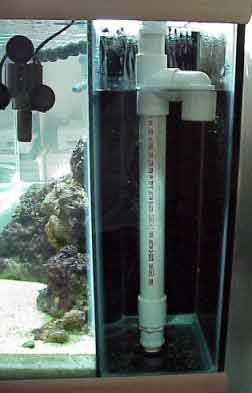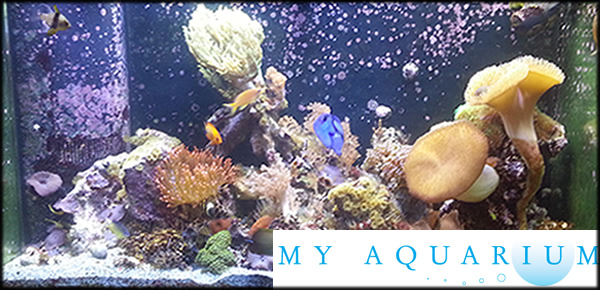Do It Yourself Durso Standpipe Project
Often when you purchase a new or used aquarium with a built in overflow it will come equipped with a perforated pipe (a tube with holes drilled all the way down the pipe) down tube inside the overflow chamber. While this allows the water to flow quickly it also keeps the water level in the overflow chamber very low.
 |
When the water level is so low in the overflow chamber the water entering the chamber has to fall anywhere from 18 to 30 inches depending on the tank height which sounds like a waterfall in your living room or office and can be very distracting. In addition to this water fall noise the perforated holes make a loud gargling noise that is constant and irritating. Fortunately there is a simple solution that can be built with simple tools and supplies that can all be purchased at your local home improvement store. The Durso Overflow Has Several Advantages:
|
PVC Size to Use
My tank has a 1 inch bulkhead on the bottom glass where the water drains out. For this size hole, I recommend you use 1¼ inch Schedule 26 PVC for the standpipe. I do not recommend 1½ inch PVC as the larger fittings are much harder to fit inside the overflow chamber. Secondly, there is no advantage in 1½ inch over 1¼ inch PVC when dealing with a 1 inch bulkhead — the bulkhead is the limiting factor for the amount of water that can drain out.
These instructions assume you will be constructing a standpipe for a 1 inch threaded bulkhead.
To Oversize or Not to Oversize
With 1 inch and smaller bulkheads the standpipe's PVC diameter needs to be larger than the bulkhead to work correctly. Typically if you use 1 inch PVC pipe on a 1 inch bulkhead you get poor results. (Some exceptions with smaller low flow tanks.) Use 1¼ inch PVC pipe. For very large tanks (350 gallon plus) with 1.5 inch bulkheads and large return pumps however, there does not seem to be any need to oversize the standpipe for larger bulkheads. Bulkheads 1.5 inches and larger can use PVC pipe & fittings that match the size of the bulkhead.
Parts of the Durso Standpipe
The bottom section:
If you have a threaded bulkhead, the first fitting is a 1 inch threaded male adapter which screws into the threaded bulkhead. Be sure to use Teflon tape on the threads, you want this to be a water tight seal. Note: A male adapter is only needed for threaded bulkhead.
Next, convert the 1 inch pipe to a 1 ¼ inch pipe using a reducer bushing. (There is a small section of 1 inch PVC pipe linking these two parts). The reducer bushing is then inserted into a coupling.
The middle section:
Then the vertical PVC pipe is inserted in the coupling. The PVC pipe I recommend is Schedule 26 commonly called thin-wall PVC pipe. It is thinner, lighter and drains better than schedule 40 pipe. The height of this section of pipe varies depending on the parts you use and how tall your aquarium is. The end goal is that when completed, the top end-cap will be about equal to the upper rim of the aquarium.
I recommend PVC cement for this connection to keep it water tight.
The top section:
At the top of the standpipe is a 1¼ Tee fitting. This is attached to the standpipe with Teflon tape only. I suggest using about three wraps to get a good tight seal. Do not glue this fitting.
A special elbow connector called a “Street-ell” or “Street 90″ is then inserted and pointed directly downwards. This is the water intake, it will always be submerged. Since it is submerged, it can not suck in surface air.
Note: A street-ell allows the ell to be inserted directly into the Tee fitting without requiring a separate small PVC pipe length to connect the elbow and tee together. A standard PVC Elbow can be used but may not be as compact as the street-ell. To fit into the older style small AGA overflows, just trim the street ell connector down. Only about ¼ inch is needed for a gluing surface.
Use PVC cement to connect the Street-Ell to the Tee. On the top part of the Tee fitting, insert a small section of PVC pipe which should be glued in. Finally place an End-Cap fitting to top the unit. The End-Cap is held on with Teflon tape.
Standpipe Air Hole
A very small hole is drilled in the top of the End-Cap fitting. This allows some air to enter into the standpipe. You will likely need to tinker with the size of the hole a bit. I would suggest starting with a 1/16 inch drill bit for the air hole in the End-Cap. If you find the water level in the chamber fluctuates quickly then the standpipe needs to suck in more air. Try a 5/64 inch drill bit to make the hole slightly larger — increasing the size if needed. Do not be surprised if you need to go as large as ¼ inch with the hole size. The lower the flow rate between display tank and sump the larger the hole size needed.
The hole on the top of the standpipe (in the End-Cap) is very important. Without the hole, a full siphon will be created and water will be sucked out of the overflow chamber too fast. The water level will drop below the intake and you will get a terrible air sucking noise. If you drill a hole and the water level still drops to far (making a sucking noise) then the hole is to small. Just make it slightly larger (see above) and the water level will raise. If you make the hole to large then the water level will be to high. (It should not overflow the tank as it will not get that high, but keep an eye on it). If the water level is too high you may need to replace the end-cap (they are cheap). Many people report that it is easier to tune with several smaller holes than a single larger hole.
Overflow Chamber Water Level
Ideally the water level in the overflow chamber will be about 1 to 2 inches lower than the display water level. This provides for gas exchange and prevents an organic film from building up on the water surface of the overflow chamber. If you designed it correctly, the water level in the overflow chamber will be a little lower than the display tank and the water level will be at about the middle of the Street-Ell fitting as pictured in the introduction page. If the water level is slightly higher, no big deal. As long as the overall water level in the chamber is lower than the display tank it is stable that is good enough.
The height of the Durso Standpipe™ is not critical. I would recommend the height of the end-cap to be about equal or slightly higher than the top plastic rim of the tank.
Exploded Parts List
The following is a break down of parts used to construct a Durso Standpipe.
 |
#10 - 1¼ PVC End-Cap with vent hole. #9 - Connector made of 1¼ PVC. Glue to Tee, Teflon taped top for snug fit with End-Cap. |


